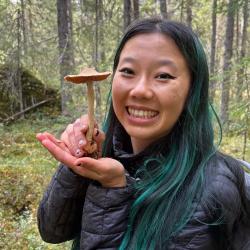Cereal symbiosis
We study the molecular mechanisms underlying the formation and function of arbuscular mycorrhizal (AM) symbiosis in rice and maize.
In order to maximise mycorrhizal benefits in crops we are studying the signaling mechanisms that enable the establishment of AM symbiosis and effective symbiotic mineral acquisition. We also aim to develop our knowledge of these associations to optimize the incorporation of the AM symbiosis into sustainable agricultural practices.
We will continue to identify and functionally characterise plant genetic determinants that impact the plant’s reprogramming for symbiosis and therefore the effectiveness of AM symbioses in rice and other cropping systems.
We would like to understand the regulation and dynamics of the symbiotic phosphate and nitrogen uptake pathway under laboratory and field conditions. This will help us exploit the symbiosis and develop cereal cultivars better adapted to low-input rice agro-ecosystems. Our approaches combine molecular genetics and advanced live imaging, covering the scales from field to cells and back.
Research areas
Rhizosphere communication
Establishment of AM symbioses relies on the continuous orchestration of signals to achieve recognition and coordination of the interacting organisms. We have identified genetic determinants of the rhizosphere dialogue from rice and maize. Their functional characterization will shed light on the communicative signal exchange, “sending” and “receiving”, that impacts on the plant’s reprogramming for symbiosis and therefore on the effectiveness of AM symbioses in rice and other cropping systems.
Symbiotic phosphate acquisition
Phosphate (Pi) acquisition of crops via AM symbioses gains increasing importance due to limited Pi reserves and demand for environmentally sustainable agriculture. We found that 70% of the Pi acquired by aerobically- grown rice is delivered via the symbiotic route. We would like to understand the functioning and regulation of this pathway under laboratory and field conditions to exploit the symbiosis and develop rice cultivars better adapted to low-input rice agro-ecosystems.
Arbuscules, the heart of the symbiosis
‘Arbuscules’ are fascinating fungal feeding structures, produced inside root cortical cells by arbuscular mycorrhizal fungi. Arbuscules are built by consecutive dichotomous hyphal branching, ultimately adopting a complex tree-like shape at microscopic scale. As the arbuscule develops, the hostplant cell undergoes fundamental architectural adaptations to accommodate the intracellularly expanding fungus.
For instance, the plant cell dramatically increases membrane biogenesis to envelope the growing hyphal structure in the so-called peri-arbuscular membrane. The hugely enlarged membrane surface area between the two organisms appears ideal for the exchange of signals and nutrients.
Remarkably, despite what seems a considerable metabolic investment, arbuscules collapse after a few days, and host cell architecture is restored to that of a non-colonized cell. Therefore, the life of an arbuscule is marked by the highly dynamic continuum of development and collapse without static intermediate stages. To capture arbuscule formation and turnover in 4D, and at ultrastructural resolution, we combine advanced multiphoton confocal imaging of living mycorrhizal rice roots with high resolution electron microscopy.
About the group leader
Uta Paszkowski is Professor of Plant Molecular Genetics at the Department of Plant Sciences of the University of Cambridge and leads the Cereal Symbiosis Group at the Crop Science Centre. She did her undergraduate studies at the University Cologne (Germany) gaining a Master (Diplom) degree in phytopathology at the Max-Planck Institute for Plant Breeding.
Uta received her PhD in Biotechnology at the ETH-Zurich (Switzerland) and conducted two postdocs on molecular genetics of arbuscular mycorrhizal symbiosis at the University Basel (Switzerland) and the Torrey Mesa Research Institute in San Diego (USA).
She started her own research group at the University of Geneva (Switzerland), followed by an Assistant Professorship position at the University Lausanne (Switzerland) before moving to Cambridge University in October 2012 where she now is a full professor.
Led by

Uta Paszkowski
Acting Director of the Crop Science Centre
Research group staff

Doris Albinsky
Barley genetics and phenotyping manager

Edwin Jarratt Barnham
Post-doctoral research associate

Lauren Eddie
PhD student

Gabriel Ferreras Garrucho
Postdoctoral Research Associate

Liam German
Postdoctoral researcher associate

Thomas Irving
Postdoctoral research associate

Min-Yao Jhu
Postdoctoral research associate

Medhavi Kakkar
PhD student

Dr Marta Lalik
Senior Chief Laboratory Technician

Chen Liu
Research Laboratory Manager

Federico Marangelli
PhD student

Jen McGaley
Postdoctoral research associate

Martina Orvošová
PhD student

Sonia Paoli
Research Assistant

Shichao Ren
Research Laboratory Technician

Miguel Ângelo Santos
Postdoctoral research associate

Emily Servante
Postdoctoral research associate

Tom Thirkell
Postdoctoral Research Associate

Esther Tok
MPhil Postgraduate Student








